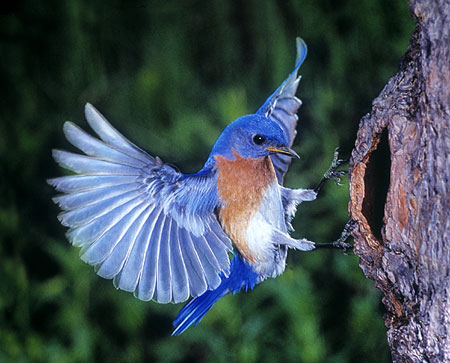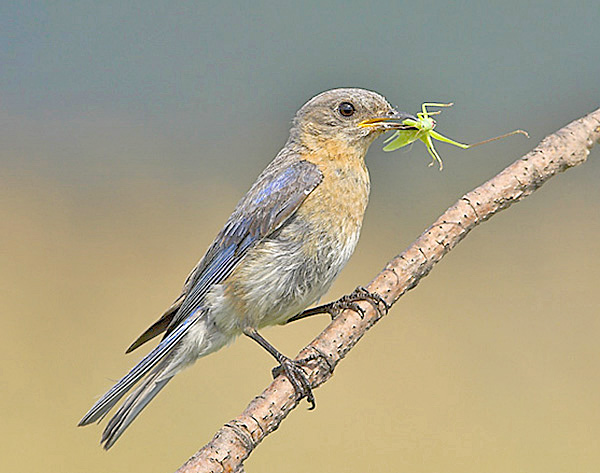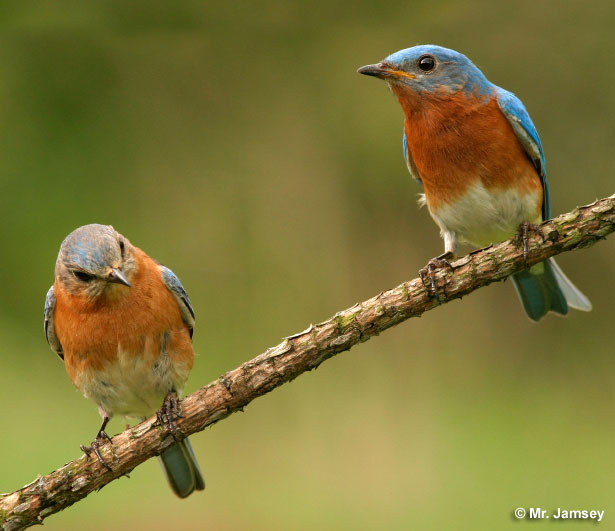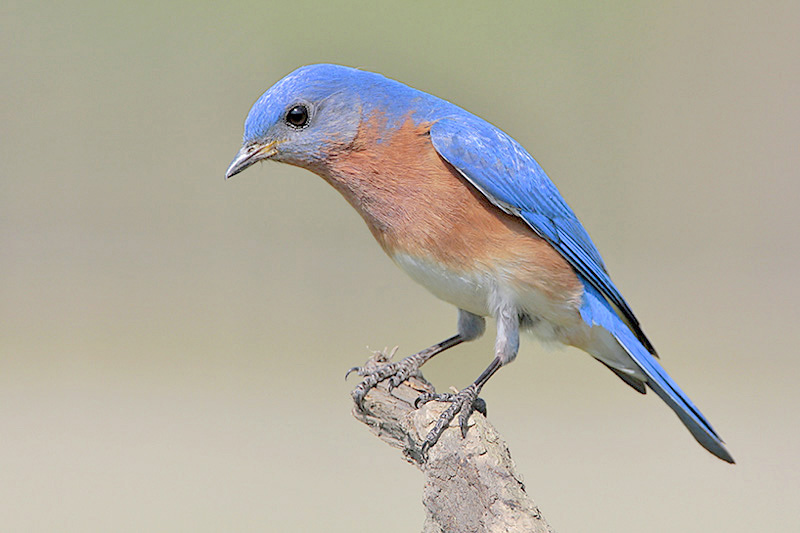
The state bird of New York is the Eastern Bluebird. This beautiful and elegant little thrush lends a touch of bright pastel blue and ripe peach to meadows, farms, and other open habitats in much of the state.
In rural parts of New York state, the Eastern Bluebird is often seen perched on roadside wires, hovering above meadows, and sitting on the nest boxes that have helped to increase numbers of this species in many areas.
New York is a mid-sized state in the northeastern part of the USA with an area of 54,556 square miles and a population of more than 20 million. One of the original thirteen English colonies that declared independence from England in 1776, New York started out as a Dutch colony known as “New Amsterdam”.
Today, New York State is mostly known for the famous metropolis of the same name, but the state also has beautiful forests, lakes, and farmlands, the Catskill and Adirondack Mountains, the scenic Finger Lakes, and shares the cataracts of Niagara and a border with Canada at Lake Ontario, Lake Erie, and the Saint Lawrence River.
History
The Eastern Bluebird (Sialia sialis)became the official state bird of New York on May 18, 1970. This lovely blue-backed bird would have become the legally recognized state bird long before then when it was named the state bird in 1928.
However, since no legislation was passed to give the decision an official stamp of approval, the Eastern Bluebird didn’t become the state’s legally recognized bird until a bill was introduced, subsequently voted on, and approved by the state legislature.

Female. Photograph © Glenn Bartley.
In 1928, in common with other states, there was a push by women’s organizations to protect and name state birds. In New York, the Eastern Bluebird was actually not the first choice for being the state bird species.
This title would have gone to the American Robin, a common and familiar bird throughout the state, but Mrs. Charles Cyrus Marshall, then president of the New York Federated Women’s Clubs, lobbied and won to give that recognition to the Eastern Bluebird.
This beautiful bird was chosen to be the official state bird for New York because it is one of the more eye-catching and pretty bird species commonly seen in rural areas of the state.
In the 1920s, on account of more farmland habitat and nest sites being available, this species may have also been more abundant than present times.
Since it lives in open areas, Eastern Bluebirds are often and easily seen on country drives through farmlands in much of the state. This small thrush was also chosen to be the state bird of Missouri.
Facts about The Eastern Bluebird
- The New York state bird won’t come to feeders with birdseed, but it will visit a feeder that has live mealworms.
- Eastern Bluebirds breed in cavities and have become very much adapted to nest boxes. They prefer nest boxes with small holes and have increased thanks to the construction of “Bluebird Trails”; areas with several nest boxes placed at 100 yard intervals.
- Although Eastern Bluebirds are often seen in pairs at nest boxes, at other times of the year, they can form flocks of dozens or more than a hundred birds that adorn roadside wires and quickly fly between fruiting trees.
- Eastern Bluebirds usually lay two clutches of eggs during the same summer breeding season.
- Like many birds, Eastern Bluebirds have very keen eyesight. They can see small insects on the ground, 100 feet away.
Identification
The male Eastern Bluebird is a rather small thrush with bright blue upperparts, and peach or reddish-orange on the throat, breast, above the shoulder of the wing, and on the flanks. The belly and undertail are white, it has more dusky, gray-blue coloration on the face, and an indistinct gray-blue ring around the eye.
This male bluebird species also has a rather short, black bill with a bit of yellowish-orange at the base, black legs and feet, and a medium-length tail.
The wings have some black highlights in the flight feathers, and are long and pointed to help it quickly fly over grass and then hover or swoop down to catch an insect. The long wings also help this species migrate short distances in search of fruiting trees. They enjoy spiders, grasshoppers, caterpillars, crickets, beetles, and other similar insects.

The female Eastern Bluebird looks rather similar to the male but has some differences. Most of the time, both sexes are very similar in size but, just after the breeding season, the female is slightly bigger.
She also has much less blue on the upperparts with bright blue mostly being restricted to the rump and tail.
Compared to the male, her head and back are also more blue-gray, she has a prominent pale ring around the eye that is wider at the back of the eye, more white in front of the eye and on and throat, and more brownish coloration on the side of the head and neck.
The juvenile Eastern Bluebird looks like the female but is darker gray with pale spotting on the back and underparts and doesn’t have any orange in its plumage.
Call
Both sexes often give a short, warbling call, while perched and in flight. The male sings a short and pretty warbling song, something like chi-wee-diwidiweer.
The vocalizations of the Eastern Bluebird don’t sound like any other species in its range and are easily recognized.
Behavior
Eastern Bluebirds spend much of their time perched on roadside wires, posts, and trees in and near open situations. They can also be seen at fruiting trees, especially during the winter when they can occur in flocks of up to 100 birds.

Photograph © Greg Lavaty.
They are very aggressive in defense of their territory and nesting sites, with other Eastern Bluebirds, and with other bird species that also use nest cavities or attack Eastern Bluebird nests.
This includes such bird species as the House Wren, House Sparrow, European Starling, Great-crested Flycatcher, Brown-headed Cowbird, and the Blue Jay.
Predators of the Eastern Bluebird that commonly attack eggs, young, or adults also include the Black Rat Snake and other snakes, Raccoons, domestic cats, American Kestrels, Fire Ants, Chipmunks, and Flying Squirrels.
They aren’t usually bothered by or afraid of people. In general, this species benefits from people who put up nest boxes for them.
Interested in more birds of the state? Most Common Birds of New York
Main Questions
What is the state bird of New York?
The state bird of New York is the Eastern Bluebird.
Why is the Eastern Bluebird the state bird of New York?
The Eastern Bluebird is the state bird of New York because it is native to the region and represents beauty and hope. Its vibrant blue plumage and melodious song make it a beloved symbol of New York’s natural diversity and vitality.
When did New York choose its state bird?
New York officially chose the Eastern Bluebird as its state bird in 1970.
What other states have the Eastern Bluebird as their state bird?
Besides New York, the Eastern Bluebird is also the state bird of Missouri and Idaho.

